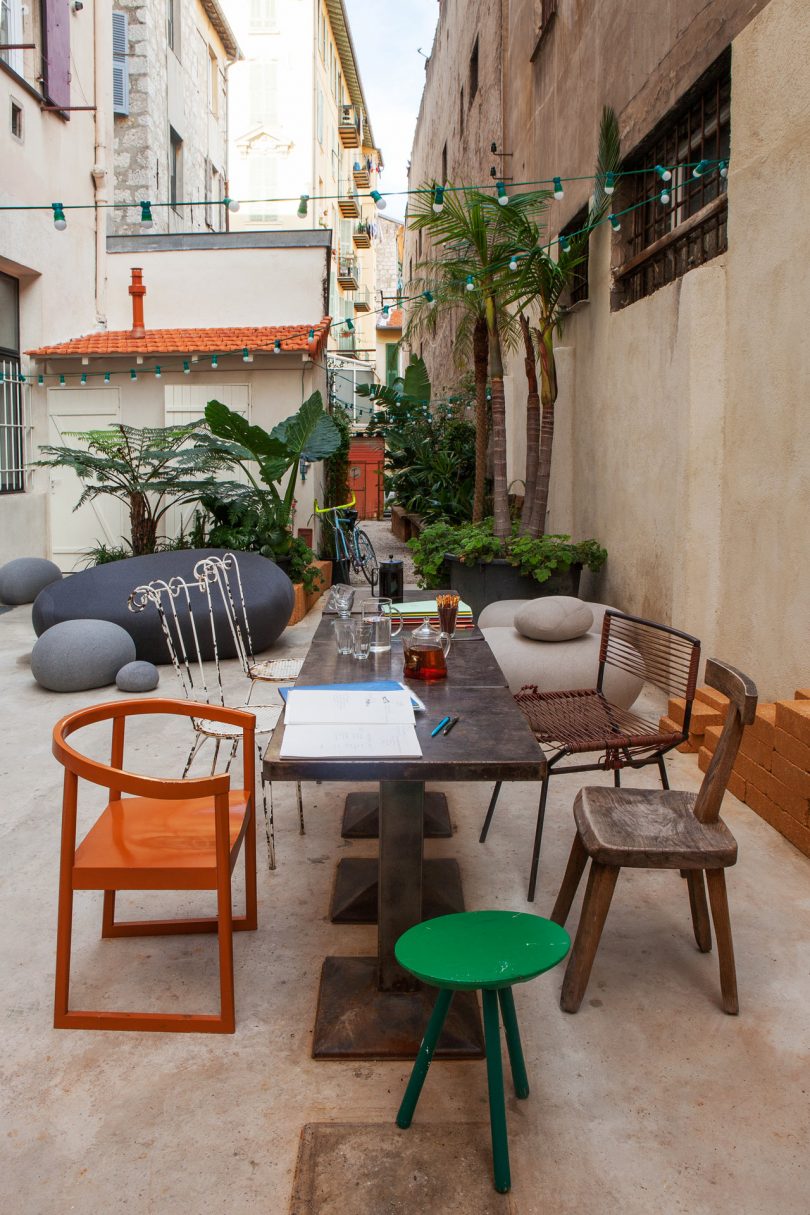Our first brush with smarin was back in 2006 when Design Milk was just a baby and our founder came across their oversized, pebble-looking pillows called Livingstones. Since then we’ve continued to appreciate the nap-worthy designs that the French brand and their founder, Stéphanie Marin, have created. For this month’s Where I Work, we virtually travel to Nice, France, to see Marin’s smarin headquarters and to investigate how and where they make it all happen.
What is your typical work style?
The studio opens quite early, but every one has a specific schedule. Mine is 10am to 6pm, with a break in midday. I often travel, for installations.
I have a coffee when I arrive, it is the first thing I do of the day. It helps me going into the work world.
We are working most of the time for public spaces and try to create new situations in various places. Although we do the production of our concepts and design in our workshop in the South of France, we also have a repertoire we produce as a small artisanal factory. Meanwhile, we have a research process, and make objects following our favorite themes, such as therapeutic and mechanic.
What’s your studio/work environment like?
I still draw, I need to model maquettes with my fingers. We love to make our prototypes by ourselves. We are experts in textiles, but also quite fluent in metal and wood solutions.
We can be messy, we love music, and we make a lot of movements – we do not stay seated all day long.
Our studio is a great experimental workshop. We have reversible equipment using our construction system Play YET ! everywhere so that our space can be adapted to all our needs which are often changing.
How is your space organized/arranged?
Our space is 1000 m2, with half the space allocated to series production, which we make ourselves. We use quite low tech tools to produce our simple textile objects. 100 m2 is for our administration team of 5 people and 400 m2 is for the conception process. There’s a simple photo or video studio and a small mezzanine office for 3 designers and myself with good devices (nas / VR / 3D / video). Finally, there’s a space for experimenting and making prototypes with basic tools and a CNC machine. We are very lucky because we are surrounded by beautiful plants and very close to the sea.
How long have you been in this space? Where did you work before that?
First, we got the 500 m2 production space in 2000. Prior to that, I was working in a village with my expert textile team where we were producing textiles with our own natural dyes.
The 500 m2 for the conception studio and administration office came in 2014. It was an old Pasta Factory and we got it in ruins and had to renovate it with chalk paints, copper plumbing, reused wood materials, and other things. We didn’t buy any new, we just repaired and made it work.
If you could change something about your workspace what would it be?
I would open a door between the administration space and the designers’ office. I would make very small offices for everyone that we could have open or closed.

Is there an office pet?
We had 4 chickens, very friendly and interested in design. Since last year we met two beautiful cat brothers who are very nice workmates.
Do you require music in the background ? if so, who are some favorites?
We love music and choose the programming together. Sometimes it is silence. We love a lot of different styles of music: classic, soul…and specially nowadays a new band, FELI XITA.
How do you record ideas?
We use drawings, plans, notes, references, and clay models.
Do you have inspiration board? What’s on now?
Not in the classic way of a mood board… Instead, we have books for ideas, philosophy, economy, micro-sociology… Our boards are related to lists of functions, scenarios, and hypothesis of different uses we want to find.
What kind of art/design/objects might you have scattered about the space?
We are our first critics, so all of our displays are tested in our space – we actually live with our prototypes and experiment with them for the long term.
It is very interesting and allows us to think about how we behave with our body. We all still sit on our sChairs since the firsts prototypes came out.
Moreover, we have strong relationships with artists such as Celeste Boursier Mougenot, Yto Barrada, Jean Dupuy, and Philippe Matula. We very much enjoy displaying their gifts in our space.
Are there tools or machinery in your space?
The telephones are now becoming quite important tools whether we like it or not. And of course our coffee machine is important
What tools do you most enjoy using in the design process?
My two favorites tools are: modeling clay and a camera, for two very different steps of the creative process.
Is there a favorite project/piece you’ve worked on?
I love Play YET ! because of the efficiency of it, the infinite possibilities, its reversible aspect, and the highly natural materials we used. I love the sChaise, especially for the fact that we succeeded to reduce the pressure points on the ischios (hamstring) and give the user naturally and constant comfort. In the near future, I want to work on different aesthetics of the sChaise.
Do you feel like you’ve made it?
Absolutely not, as I am inventing my processes and my practice, I always have a lot to think about. I am worried about our world. This is driving me to think and rethink about the proposals we can make in economic sustainable models, taking into account the ecological impacts but also the renewed social relations such as the future of work. There is so much to do.
What has made you feel like you’ve become successful?
I felt very happy when I became able to have an apartment out of the workshop. Success in the design game is very relative. The marketing and the importance of the work are not always proportional. The financial equilibrium is necessary, and this is a first sign of sustainable success.
My research makes me feel successful when, for example, I am very well seated on the sChaise.
At what moment/circumstances have you felt successful?
The success of the Sifflu made me happy because I designed it on the request of an editor for a kind of designer’s box. He refused the project because this was too crazy! I was able to make it anyway, and made it existing in the design field. I got encouragement from the medical world and that was great. Same thing for Sign System, one of our new projects, thought as a new sort of typology. This project’s development allowed us to meet very interesting partners in the research field.
Or what will it take to get there?
I would love to keep on meeting very good project partners, in the architecture field and environmental research.
Tell us about a current project you’re working on.
I am constantly working on a number of projects, including large scale projects such as project requests, future collaborations with artists, or cultural institutions. My conception of design includes taking into account these 3 scales.
Nowadays we are thrilled to work on two ambitious projects among others:
– a new set up/disposal for public space making an inter-relation place for scientists and students.
– a reflexology object that proposes a new healthy and funny habit.
Do you have anything in your home that you’ve designed/created?
As I never buy anything new, I am surrounded by our prototypes. I can experiment with all my principles, critic them, and imagine others.
















































